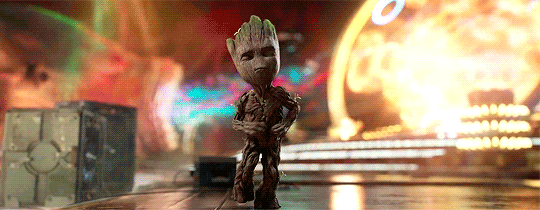Guardians of the Galaxy is a 2017 sequel American superhero film based on the Marvel Comics produced by Marvel Studios. In the movie, Peter Quill and his fellow Guardians are hired by a powerful alien race to protect their precious batteries from invaders. When it is discovered that Rocket has stolen from them, they dispatch their armada to search for vengeance. As the Guardians try to escape, the mystery of Peter's parentage is revealed.
I chose to study this film opening because I enjoyed its colour and sound aspects and I wanted to research a variety of genres before I made my decision as to what style I was going to give my own film opening.
The creators have successfully created a comedic opening that highlights the genre and style of the piece. This is achieved through several techniques, for example, the use of shot types. Throughout the opening, the creators use an all-in-one shot in which the camera follows Groot around the scene. This is effective because we are able to see Groot in the foreground but behind him are the Guardians fighting against an enormous octopus-like alien with sharp teeth and long tentacles. The audience are able to laugh as Groot is oblivious to the scene surrounding him despite being right in the middle of it but they also understand the superhero themes of the movie through the action happening in the background. As well as this, the focal point of the sequence is Groot and his dance moves which not only reiterates a cheery and humorous emotion for the reader as he is so unaware of everything going on around him and the danger he is in but also is effective in character development. The audience can understand Groot's role within the Guardians as well as the other characters qualities such as Gamora, Rocket and Peter Quill who look out for him showing their bond with each other.

The audio codes are what directs the sequence and has the most effect on the audience. Numerous sound techniques are used the most important being the non diegetic sound. Baby Groot initiates the start of the music when he plugs in a speaker, which is followed by the track 'Mr Blue Sky' by Electric Light Orchestra. This track is very upbeat and dance-like and does not match the scenario going on in the background - making it contrapuntal sound. This is effective as it reinforces the light-hearted style of the movie and makes the audience feel joyful and want to dance along with Groot despite the violent action going on simultaneously. Furthermore, the creators also make the audience feel as if they are in the scene because they use diegetic and synchronous sound. We can hear the sound effects of the battle such as explosions as well as the noises coming from the guns, the roar of the monster and the dialogue from the characters. Because the audience can hear both diegetic and non diegetic sound, they can fully immerse themselves into the movie.
Mise en scene is effective in presenting the location and style of the movie because instantly, from the start of the film, we can tell it is not set on earth. This is hinted through the extreme colour palette for example, the ray of colours that come out of the monster's mouth and the actual monster itself is not the kind of concept we would see if this were set on Earth. Equally, the set on screen consists of gold structures with revolving lights and shiny, metallic platforms which hints at a very futuristic theme set in space and adds to the atmosphere of the scene. This theme is further developed through the font and style of the credits on screen. The producer and cast names appear in a cyan blue which looks lit up like a light. This visual element adds to the space-like atmosphere as it creates a pop of colour whilst adding to the ultramodern style.










